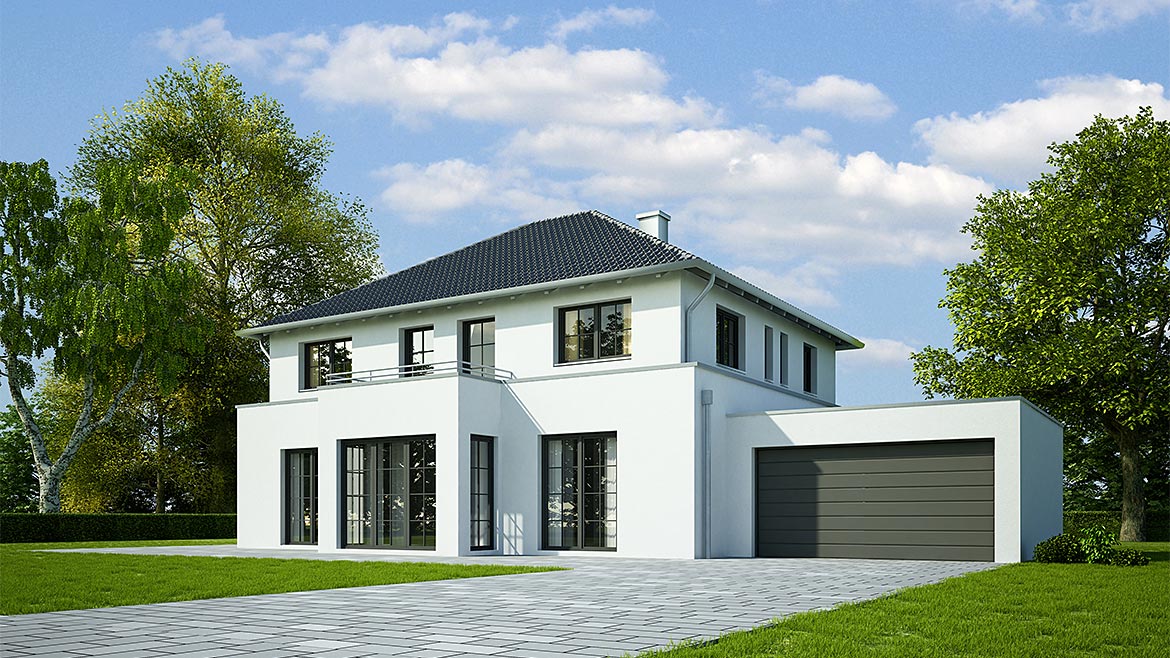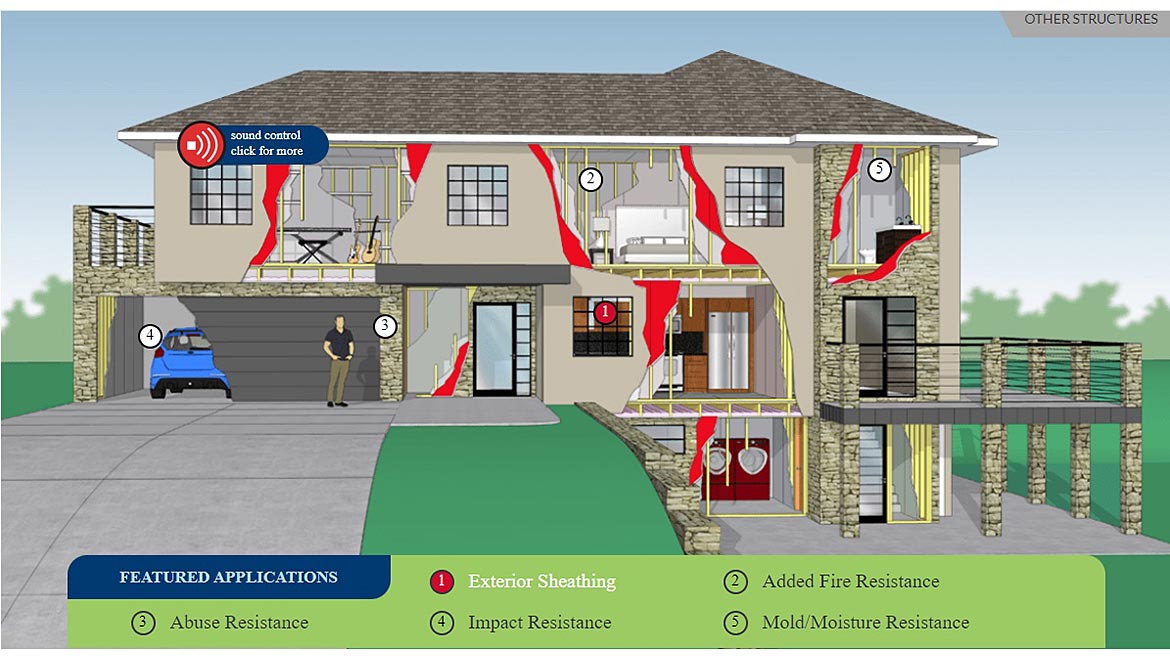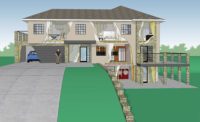Drive through any urban area and you will notice high rises under construction, sheathed with the bright colors of glass mat gypsum sheathing. These gypsum panels are also seen on façades of single-story fast-food restaurants, offices and residential towers, hospitals and mixed-use structures. The advantages of glass mat gypsum sheathing are many. The panels offer extended weather protection, mold and moisture resistance, and—thanks to its type X core—exceptional fire resistance. The ability to score and snap the panels means easier and more efficient construction. In addition, numerous claddings lend themselves to application over exterior glass mat gypsum sheathing, including the increasingly popular metal panel systems, stucco, vinyl and composite siding products.
Glass mat gypsum sheathing has gained widespread acceptance in the commercial building sector. Yet, use of this gypsum sheathing product remains rare in residential construction. Interested homebuilders are out there, and over recent years, the Gypsum Association has been hearing from them with increasing frequency. They want to know how to use this material. It is true that the International Residential Code, to which most builders of one- and two-story dwellings must adhere, is oriented around wood-based sheathing materials. However, only a little digging is necessary to discover the rules around building a code-compliant residence using glass mat gypsum sheathing.

Could this single-family home be constructed with glass mat gypsum sheathing? The answer may surprise you.
Recent History
ASTM C1177 (Standard Specification for Glass Mat Gypsum Substrate for Use as Sheathing) is the manufacturing standard for glass mat gypsum sheathing in North America. The standard was first released in 1991, soon after the introduction of glass mat gypsum sheathing to the marketplace. This addition to the family of gypsum panel products, which include the ubiquitous gypsum wallboard, is faced with a glass fiber on front, back and long edges and features an enhanced moisture-resistant Type X core. It is not subject to the ill effects of freeze-thaw cycles and is dimensionally stable. The fact that glass mat gypsum sheathing retains its integrity for months despite exposure to the elements is a major factor in the product’s commercial success. Concerns about exposure to rain, snow and sleet are diminished when exterior gypsum sheathing is used.
Glass mat gypsum sheathing is noncombustible, as defined by the building codes. For this reason, when new commercial structures are built on narrow parcels near adjacent buildings or lot lines, it is not uncommon for the exterior wall closest to an existing structure or lot line to take advantage of C1177 panels, even when different underlayments are used for the rest of the building. In these situations, achieving an appropriately high fire-resistance rating for even a single exterior wall is easier with glass mat gypsum sheathing.

This image from the GA’s web-based resource on Special Performance Gypsum Panels, illustrates the use of glass mat gypsum sheathing in residential construction. Learn more at www.gypsum.org/single-family/
Residential Considerations
All structures stand to benefit from the natural mold and moisture resistance and increased fire protection C1177 sheathing offers. Wildland fires increasingly threaten populous communities. Weather events hamper construction schedules, regardless of the building sector. Given that it is primarily used in commercial construction, an overlooked attribute of glass mat sheathing is its lack of susceptibility to wood-boring insects, a problem that homeowners in certain geographies must guard against zealously. So, why do we not build homes with glass mat gypsum sheathing?
While wood-based panels are the default, C1177 sheathing is a code-compliant sheathing substrate for residential construction in the majority of the United States. A 115-mile-per-hour ultimate wind speed is a limitation, but aside from some region-specific special wind areas, much of the U.S. is in the 115 miles per hour or less category. Similarly, seismic considerations do not significantly affect most of the country. In areas classified with a low seismic design category per IRC Section R301.2.2, the residential lateral design is governed by the wind force design information in the IRC. It is in this large geographic area that glass mat gypsum sheathing works best.
How to Build with C1177 Sheathing
The application techniques for glass mat gypsum sheathing are very similar to those used to install interior wallboard. The panels are sized by cutting and snapping—obviating the need for power tools. Glass mat gypsum sheathing is fastened with screws or nails. Unlike gypsum wallboard, however, the joints between installed gypsum sheathing panels are not regularly treated or finished, unless required by the specific cladding system or air/weather barrier manufacturer.
Wood may be the default sheathing for residential builders, but the IRC provides prescriptive pathways for a number of alternative sheathings, including gypsum panels. The key to building with many alternative sheathing materials is construction that includes bracing within the design of the walls themselves. Combining the inherent strength of both interior and exterior gypsum panels with additional bracing strategies results in a sturdy dwelling capable of resisting wind loads and racking.
Braced wall panels are the components of the braced wall lines that form the building envelope. IRC prescriptive requirements define the length (horizontal width) and placement parameters of individual braced wall panels, the number of braced wall panels required in a specific braced wall line, and the construction requirements for the gypsum panels used on one or both faces of a braced wall panel.
Code-compliant one- and two-story dwellings can be built using glass mat gypsum sheathing by following the prescriptive requirements of IRC Table R602.10.4. It is possible to take advantage of the superior fire, insect, mold and moisture resistance offered by these special-performance gypsum panels. The devil is very much in the details, however. As a writer in the August-September 2022 issue of Fine Homebuilding noted about his efforts to build a house without plywood or OSB, “It takes a little head-scratching to build a braced wall system that omits solid wood panels. The code is cumbersome.” Fernando Ruiz, the author of that article, ultimately succeeded with help from a professional engineer friend.
While advice specific to your project specifications is always warranted, the Gypsum Association can help. The association recently completed a guidance document on the use of glass mat gypsum sheathing in IRC-compliant construction. Visit gypsum.org to download Glass Mat Gypsum Sheathing: An Alternative Residential Sheathing Substrate.






Report Abusive Comment